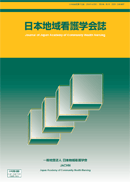Volume 12, Issue 1
Displaying 1-8 of 8 articles from this issue
- |<
- <
- 1
- >
- >|
-
Article type: Article
2009 Volume 12 Issue 1 Pages 35-43
Published: October 30, 2009
Released on J-STAGE: April 20, 2017
Download PDF (1214K) -
Article type: Article
2009 Volume 12 Issue 1 Pages 44-49
Published: October 30, 2009
Released on J-STAGE: April 20, 2017
Download PDF (1261K) -
Article type: Article
2009 Volume 12 Issue 1 Pages 50-58
Published: October 30, 2009
Released on J-STAGE: April 20, 2017
Download PDF (1292K) -
Article type: Article
2009 Volume 12 Issue 1 Pages 59-64
Published: October 30, 2009
Released on J-STAGE: April 20, 2017
Download PDF (902K) -
Article type: Article
2009 Volume 12 Issue 1 Pages 65-71
Published: October 30, 2009
Released on J-STAGE: April 20, 2017
Download PDF (1129K) -
Article type: Article
2009 Volume 12 Issue 1 Pages 72-79
Published: October 30, 2009
Released on J-STAGE: April 20, 2017
Download PDF (1103K) -
Article type: Article
2009 Volume 12 Issue 1 Pages 80-86
Published: October 30, 2009
Released on J-STAGE: April 20, 2017
Download PDF (1102K) -
Article type: Article
2009 Volume 12 Issue 1 Pages 87-94
Published: October 30, 2009
Released on J-STAGE: April 20, 2017
Download PDF (1171K)
- |<
- <
- 1
- >
- >|
